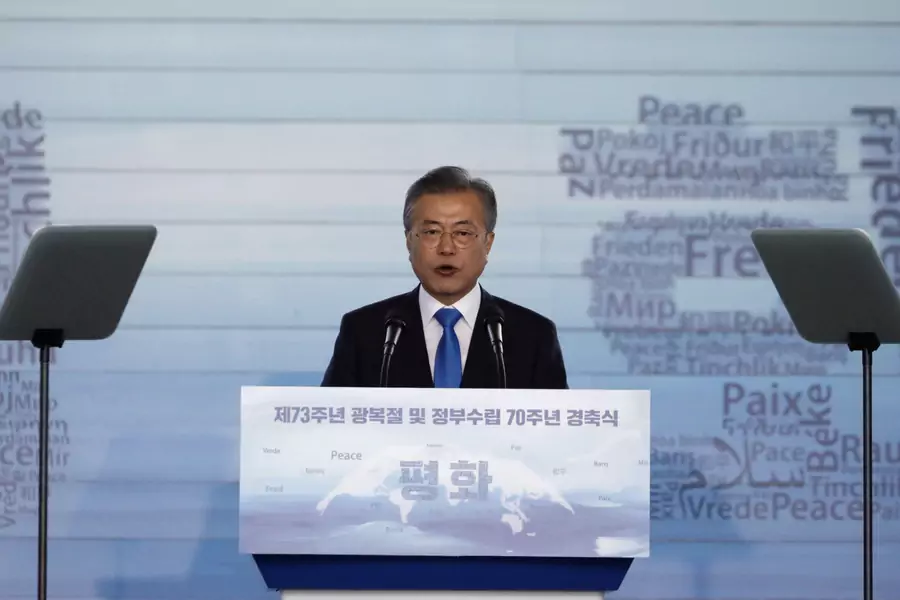Moon Jae-in’s 2018 Liberation Day Speech and South Korea’s Foreign Policy

The commemoration marking the anniversary of the end of World War II is always a bittersweet moment in South Korea. It marks a day of euphoria on the Korean peninsula that carries with it both the legacy of the past and the burdens of the future. As Korean War historian Sheila Miyoshi Jager observes, “Korea was not liberated by Koreans, and so Korea was subjugated to the will and wishes of its liberators.” Moon Jae-in’s speech marking the seventy-third anniversary of the end of World War II is particularly fascinating in its bold effort to challenge that assertion. This can be seen both through Moon’s efforts to redefine South Korea’s fraught diplomatic relationship with Japan and for the insight the speech provides into Moon’s audacious and potentially risky effort to redefine inter-Korean relations and reshape the geopolitical landscape in Northeast Asia.
Moon’s efforts to come to terms with Korea-Japan relations are particularly conflicted. Moon begins his speech by asserting that “The history of pro-Japanese collaborators was never a part of our mainstream history.” Instead, Moon defines a liberation narrative that celebrates South Korean agency by drawing on South Korea’s impressive post-war accomplishments as the only former colony to “succeed in achieving both economic growth and democratic progress.”
More on:
But the examples Moon uses in his speech to demonstrate Korea’s desire for liberation in his speech all involve resistance to Japanese colonial rule. In addition, Moon’s rejection of the terms of the December 2015 comfort woman agreement made by his predecessor led the Moon administration to establish August 14 as a new holiday, Comfort Women Memorial Day, and to launch a new think tank devoted to comfort woman research, the Women’s Human Rights Institute of Korea.
Moon stated his Comfort Women Memorial Day address his view that the comfort woman issue cannot be solved diplomatically, but rather should be addressed through global consciousness-raising about sexual violence against all women. Unfortunately, Moon’s message was badly undercut domestically since it coincided with the South Korean judicial acquittal of former South Chungcheong provincial governor Ahn Hee-jung on charges of raping his secretary.
Rather than helping to marginalize Japan’s historical legacy as part of Korea’s liberation narrative (and thus reducing its salience as a diplomatic stumbling block), the steps Moon has taken thus far appear more likely to perpetuate it, just as Japan’s establishment of Takeshima Day (to mark Japan’s claim to the island that South Korea effectively occupies and refers to as Dokdo) strained Korea-Japan relations over a decade ago during the administration of Roh Moo-hyun in which Moon previously served.
These developments have contributed to a hardening of public opinion over the comfort woman issue within the past year in both Japan and South Korea, as shown in the 2018 annual Genron NPO-East Asia Institute (EAI) Joint Poll on Japan-Korea relations and other polls. (Interestingly, the Genron-EAI shows that a plurality of Japanese and a majority of South Koreans support strengthened trilateral security cooperation among the United States, Japan, and South Korea.) Under Moon and Abe, Japan-South Korea relations appear cordial, but fragile.
The centerpiece of Moon’s speech on the future of the inter-Korean relationship turns on the phrase “taking responsibility for our fate ourselves” as a way to overcome historic divisions that have hobbled Korea’s autonomy. Moon outlines his administration’s efforts to win international support for his efforts to promote regional peace and prosperity, including agreement with President Donald Trump to “resolve the North Korean nuclear issue in a peaceful manner.”
More on:
Looking forward to a third inter-Korean summit in Pyongyang, Moon declares the objective of the meeting as “an audacious step to proceed toward the declaration of an end to the Korean War and the signing of a peace treaty as well as the complete denuclearization of the Korean peninsula.” Moon then presents a bipartisan vision of Korean peninsula-centered Northeast Asian economic integration, beginning with his proposal to establish an East Asian Railroad Community. This is a concept that has been endorsed under various names by every South Korean president since Kim Dae Jung. It is evocative of the same elements contained in the Eurasian Initiative and Northeast Asia Peace and Cooperation Initiative (NAPCI) launched by Moon’s discredited predecessor, Park Geun-hye.
The key to unlocking a new way forward, according to Moon, is Korean leadership as “the protagonists in Korean peninsula-related issues. Developments in inter-Korean relations are not the by-effects of progress in the relationship between the North and the United States. Rather, advancement in inter-Korean relations is the driving force behind denuclearization of the Korean Peninsula.” It is a bold approach that places South Korea at the crossroads of Northeast Asia and crystallizes Moon Jae-in’s efforts to manage the conflict between South Korea’s desire for autonomy and its need for alliance. The coming weeks and months will test whether Kim Jong Un—and President Trump—accept Moon’s proposition that a Korean peace will catalyze regional and global stability.
 Online Store
Online Store